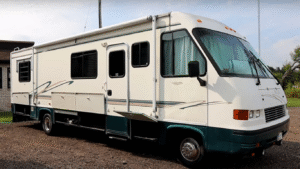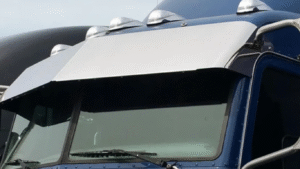Driving through Arizona means dealing with everything from intense sun to flying gravel, especially on highways like the I-10. While a chipped or cracked windshield might seem like no big deal, it can actually lead to fines—or worse, compromise your safety.
Arizona takes windshield safety seriously because even a small crack can distort your view or become a bigger hazard over time. Obstructed visibility is one of the leading contributors to accidents. If law enforcement notices your view is blocked—even by a sticker or tint—you could be stopped and ticketed.
Knowing what’s legal (and what’s not) when it comes to repairs, tint, and replacements helps you avoid penalties, pass inspections, and most importantly—stay safe on the road.
What Are Windshield Laws in Arizona?
Understanding Arizona’s windshield laws is crucial not only to avoid fines but also to ensure optimal visibility and safety while driving.
Crack Size Limitations
Arizona law does not specify exact dimensions for permissible windshield cracks or chips. Instead, the focus is on whether such damage obstructs the driver’s clear view. According to Arizona Revised Statutes §28-959.01(B), operating a vehicle with any object or material that obstructs or reduces a driver’s clear view through the windshield is prohibited. Therefore, if a crack or chip impairs your line of sight, it could lead to a traffic stop and potential penalties.
Obstruction of View Rules
Beyond windshield damage, Arizona law prohibits placing objects or materials on the windshield that obstruct the driver’s clear view. This includes items like dash-mounted GPS units, air fresheners hanging from the rearview mirror, or non-compliant sun shades. Per Arizona Revised Statutes §28-959.01(B), such obstructions are illegal and can result in citations.
Tinting Regulations
When it comes to windshield tinting, Arizona permits non-reflective tint along the top of the windshield above the manufacturer’s AS-1 line. The AS-1 line is typically marked on the windshield and runs parallel to the top edge, approximately 5 to 6 inches down. Applying tint below this line is not allowed. For detailed specifications, refer to Arizona Revised Statutes §28-959.01(C).
Sticker and Decal Placement
Arizona law allows for the placement of federal, state, or local certificates or stickers on the windshield as required by applicable laws. However, placing unauthorized stickers or decals that obstruct the driver’s clear view is prohibited. It’s essential to ensure that any stickers or decals are positioned in a manner that does not impair visibility. For more information, see Arizona Revised Statutes §28-959.01(E).
Windshield Visors or Aftermarket Films
Sun visors or aftermarket films are permitted as long as they are installed above the AS-1 line and do not obstruct the driver’s clear view. Any material that alters the color or reduces the light transmittance of the windshield below the AS-1 line is not allowed. Compliance with these regulations ensures adherence to Arizona Revised Statutes §28-959.01(C).
What Happens if You Break Windshield Laws?
Driving with a damaged windshield in Arizona isn’t just a minor inconvenience—it can lead to legal penalties, safety risks, and insurance complications. Here’s what you need to know:
Legal Consequences
- Citations and Fines: If a windshield crack obstructs your view, law enforcement may issue a citation. Fines can vary by county, but they typically range from $100 to $150. Often, these are “fix-it” tickets, meaning if you promptly repair or replace the windshield, the fine may be waived.
- Window Tint Violations: Non-compliant window tinting can result in fines up to $250 per violation. First-time offenders might receive a “fix-it” ticket, allowing them to correct the issue for a reduced fine.
Insurance Implications
- Coverage Options: Arizona law requires insurers to offer a $0 deductible glass coverage option with comprehensive policies. If you have this coverage, your insurer will pay for windshield repairs or replacements without out-of-pocket costs. However, not all policies include this by default, so it’s essential to confirm with your provider.
- Impact on Premiums: Filing a claim for windshield repair under comprehensive coverage typically doesn’t raise your premiums, especially if it’s a no-fault claim. However, frequent claims might prompt your insurer to reassess your policy terms.
Safety Concerns
- Impaired Visibility: Cracks or chips can distort your view, increasing the risk of accidents, particularly under challenging driving conditions.
- Structural Integrity: The windshield contributes significantly to your vehicle’s structural strength. Damage can compromise its effectiveness, especially during collisions or rollovers.
Address windshield damage promptly to avoid legal issues, maintain safety, and ensure seamless insurance claims. Regular inspections and timely repairs are key to safe driving in Arizona.
Tips to Stay Compliant with Arizona Windshield Laws
Staying compliant with Arizona’s windshield laws is essential for your safety and to avoid potential legal issues. Here are some practical tips to help you adhere to these regulations:
1. Regular Vehicle Inspections
Periodically inspect your windshield for any cracks, chips, or damage. Even minor imperfections can escalate, potentially obstructing your view and violating state laws. Addressing these issues promptly ensures clear visibility and compliance with safety standards.
2. Choose Certified Installers for Repairs and Replacements
When repairing or replacing your windshield, opt for certified professionals who are well-versed in Arizona’s legal requirements. They can ensure that the materials and installation methods meet state standards, helping you avoid future complications.
3. Understand and Adhere to Tinting Regulations
Arizona has specific rules regarding window tinting:
- Windshield: Non-reflective tint is permitted only above the manufacturer’s AS-1 line.
- Front Side Windows: Must allow more than 33% of light to pass through.
- Rear Side and Back Windows: Any darkness can be used, but if these windows are tinted, the vehicle must have dual side mirrors.
Familiarize yourself with these regulations before customizing your vehicle to ensure compliance and avoid potential fines.
4. Maintain Clear Windshield and Windows
Avoid placing stickers, decals, or other objects on your windshield or windows that could obstruct your view. Arizona law prohibits any material that reduces the driver’s clear view.
5. Stay Updated on Legal Changes
Laws can evolve. Regularly consult the Arizona Department of Transportation (ADOT) or the Arizona Revised Statutes to stay informed about any updates or changes to vehicle regulations.
By following these guidelines, you can ensure your vehicle remains compliant with Arizona’s windshield laws, enhancing your safety and that of others on the road.
Arizona’s Free Windshield Replacement Law: What It Really Means for You
In Arizona, drivers with comprehensive auto insurance have a big advantage—you may be eligible for free windshield repair or replacement without paying a deductible. This is thanks to a state law that requires insurers to offer zero-deductible glass coverage as part of their comprehensive plans.
So, if your windshield gets chipped or cracked, you can get it fixed without pulling out your wallet—as long as your policy includes this glass coverage option.
Why does this matter so much in Arizona? Because our weather is brutal on windshields. Hot days and cool nights can cause glass to expand and contract quickly, turning tiny chips into large, dangerous cracks. That rapid shift in temperature puts your windshield under thermal stress, which can affect your visibility and safety.
To help drivers avoid these risks and encourage quick, proactive repairs, Arizona lawmakers passed this law—protecting both your car and your peace of mind.
Frequently Asked Questions
Yes, if the crack obstructs your view or appears unsafe, an officer can legally stop you—even if you haven’t committed another traffic violation.
No, Arizona law doesn’t mandate original equipment manufacturer (OEM) glass. However, your insurance may specify glass quality or installation standards depending on your coverage.
Most standard windshield replacements take between 30 minutes to an hour, though curing time (before you can drive) may extend up to 2 hours depending on the adhesive used.
Yes, mobile windshield services are legal and very common. As long as the technician is certified and follows state safety guidelines, there’s no issue.
Windshield tint is not a part of emissions testing, but it can cause you to fail a vehicle safety inspection if it doesn’t comply with tint regulations.
Usually yes, especially if you have $0 deductible glass coverage. Most insurers treat glass claims under comprehensive coverage, which typically doesn’t raise rates—unless claims become frequent.
Yes, commercial vehicles are often held to stricter inspection standards. Fleet vehicles, for instance, may require immediate replacement for any crack, even small ones, based on DOT safety rules.





